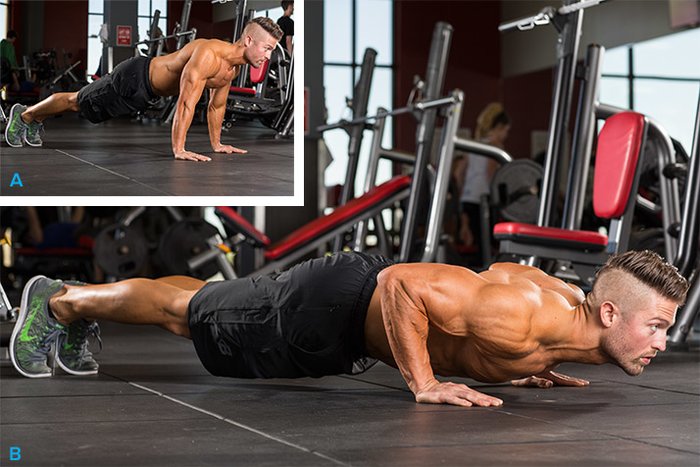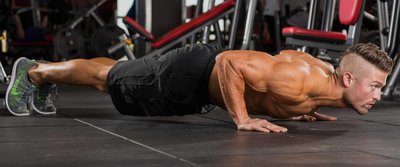With all the new fitness trends and exercises getting camera time these days, the simple push-up can seem a little quaint. It's not something you often see anyone doing on their Instagram feed or bragging about in the comments. After all, why hit the deck to do basic sets of up-downs in a gym full of chest and shoulder equipment that's begging for you to load up on it?
Well, my dear fit friends, there are actually many reasons to heed the call of this classic upper-body exercise. Let's take a look at some of the unique benefits of the push-up, and then break down how to put it back into your program where it belongs.
Why Push-ups Are Worth Your While
You might think a bodyweight exercise like the push-up doesn't provide enough "resistance" to stimulate growth and development of the chest, triceps, and shoulders. While it's true you can't replicate the same levels of absolute force you need when you perform, say, a 300-pound bench press, that doesn't mean the movement is a waste of time.
When muscle size is the goal, it's crucial to remember that what matters more than the weight lifted is the level of exertion your muscles experience. In simple terms, building muscle is largely (but not completely) a product of doing whatever it takes to fatigue and exhaust those muscles. It's why systems like German volume training (10 sets of 10 reps) work so well for hypertrophy despite the "light" loads the lifters are asked to use when doing it.

Push-up
But why do 10 sets of 10 push-ups rather than the flat bench, incline bench, or chest press machine? It's all about what happens on the back of your body. In all of these bench presses, "good form" demands that your shoulder blades remain pinned to the bench throughout the movement. This can make for a stronger, safer bench, but it doesn't promote proper shoulder function at the end of the day. Your scapulae are designed to move, not just retract. You need to train both actions!
Enter the push-up, which allows for free mobility of the scapulae. When done right, with your shoulder blades separating and protracting at the top, the push-up is one of the best activators of the serratus anterior muscles. Use my video on scapular mobility as a visual aid:
Lee Boyce on Scapular Mobility
Watch the video - 3:37
Make sure to unlock your shoulders and spread your scapulae at the top of the movement. Both strengths are crucial if you dream of ever putting up a monster overhead press or bench, and will help ensure a longer, more productive lifting career overall.
Progressing to the Push-Up
There's no shame in not being able to do a clean push-up. You'd be surprised how many otherwise strong people struggle to do good-looking push-ups, for the simple reason that they haven't been doing them. Luckily, there's an easy solution to this problem: Start where you are now, and get better by practicing, dammit!
People who can't do full-range push-ups from the toes often resort to planting their knees on the floor and doing modified push-ups. Women in particular are taught that this is the way to go, but in my opinion, this method creates too many opportunities to "cheat" on the way up. For that reason, it doesn't carry over as well to the real deal as it should. (And just to be clear, the "real deal" is the goal for men and women alike.)
Instead of going for your knees, I recommend getting used to doing push-ups from your toes by adding a slight elevation to your hand surface. The Smith Machine is a great tool here. Start at as high a level as you need, and focus on maintaining a rigid torso. Progression is as simple as lowering the bar to the next notch down.
A second option would be band-assisted push-ups, either with the band looped around the top of a rack, or even better, around the J-hooks.
Tony Gentilcore Band Assisted Push Up
Watch the video - 0:16
Using a band creates assistance where you may need it the most, deep in the hole, and reduces it where you need it the least, at lockout. To progress this version of the push-up to an unassisted move, use a skinnier band, or set the band at a lower point, so it's not providing as much help as before.
How Deep Should I Go?
My answer to this question is not what you'll hear on most Saturday-morning TV aerobics classes, where a 90-degree angle "blanket rule" is applied due to a combination of low knowledge and safety concerns. In truth, how deep you drop depends on you and your shoulder health. Different people have different construction to their shoulder anatomy, as well as different injury and lifestyle histories, so bearing load in deep positions can cause varying amounts of discomfort.
With that said... In an ideal world, the human body should be able to bear load in any position pain-free, within reason. So if you don't have a history of shoulder injury and you're pain-free, there's no reason why you shouldn't go to full range of motion when performing push-ups, as long as it doesn't hurt you to do it. So the answer is, "Get down to the floor—unless you have a good reason not to!"
How Many Push-ups Should I Do?
In my opinion, the push-up is an exercise where volume is king. It doesn't mean you have to pull a Rocky Balboa out of the gates and gun for sets of 75 at a time. Chances are your form and technique will deteriorate over the course of the set if you do this.
What it does mean, however, is that building up to doing multiple sets of 15-20 reps is a better ultimate goal than stopping once you can knock out a few sets of 6-8 reps. Expose those muscles to plenty of reps, especially if you want to add size and thickness to your chest and triceps. Take advantage of your body weight, use shorter rest intervals, and crank them out.
How Do I Program Push-ups?
Push-ups seem simple, but you'll get the most bang for your buck if you program them smartly. Remember, they're still a pressing movement, meaning they'll create stress on the shoulder joints if they're not prepared to bear the load.
Personally, I don't recommend starting off with straight push-ups while cold. Prepare your shoulders by promoting some stability through pulling exercises. Any row variation is a good way to put some blood into the scapular muscles and light up the tissue to protect the shoulder capsules. Personally, I love pairing paused lat pull-downs with push-ups.
Lee Boyce Paused Rep Lat Pull-downs
Watch the video - 0:33
Other pulling movements—both horizontal and vertical—will work well here. But in general, I like programming push-ups (or any press movement, for that matter) after pull movements. So, if you're doing a full upper-body workout, it's smart to put push-ups second in your supersets, after your back exercises.
Programming push-ups first (after your warm-up) will prefatigue you if you have any other big pressing movements planned. This can work well for some goals, but if you're going after raw strength with your big pressing moves, it would be a better idea to save the push-ups for afterward.
Push-ups also work really well as a chest-day finisher. The push-up is a fairly big movement that, done with high reps at the end of your session, can provide a metabolic "kick," a massive pump, and a release of additional hormones.
Push On!
You haven't outgrown the push-up. Going old school and adding a few sets to your program could be the smartest choice you make this year. Not only will it promote healthier shoulder function, it'll keep you in mastery of your own body weight. Sometimes, we get so caught up lifting weights that we forget this important skill. Relearn it, and you won't regret it.
If you're looking for a high-intensity program that incorporates bodyweight movements like this, check out Andy Speer's Total Fitness on Bodybuilding.com BodyFit Elite.

